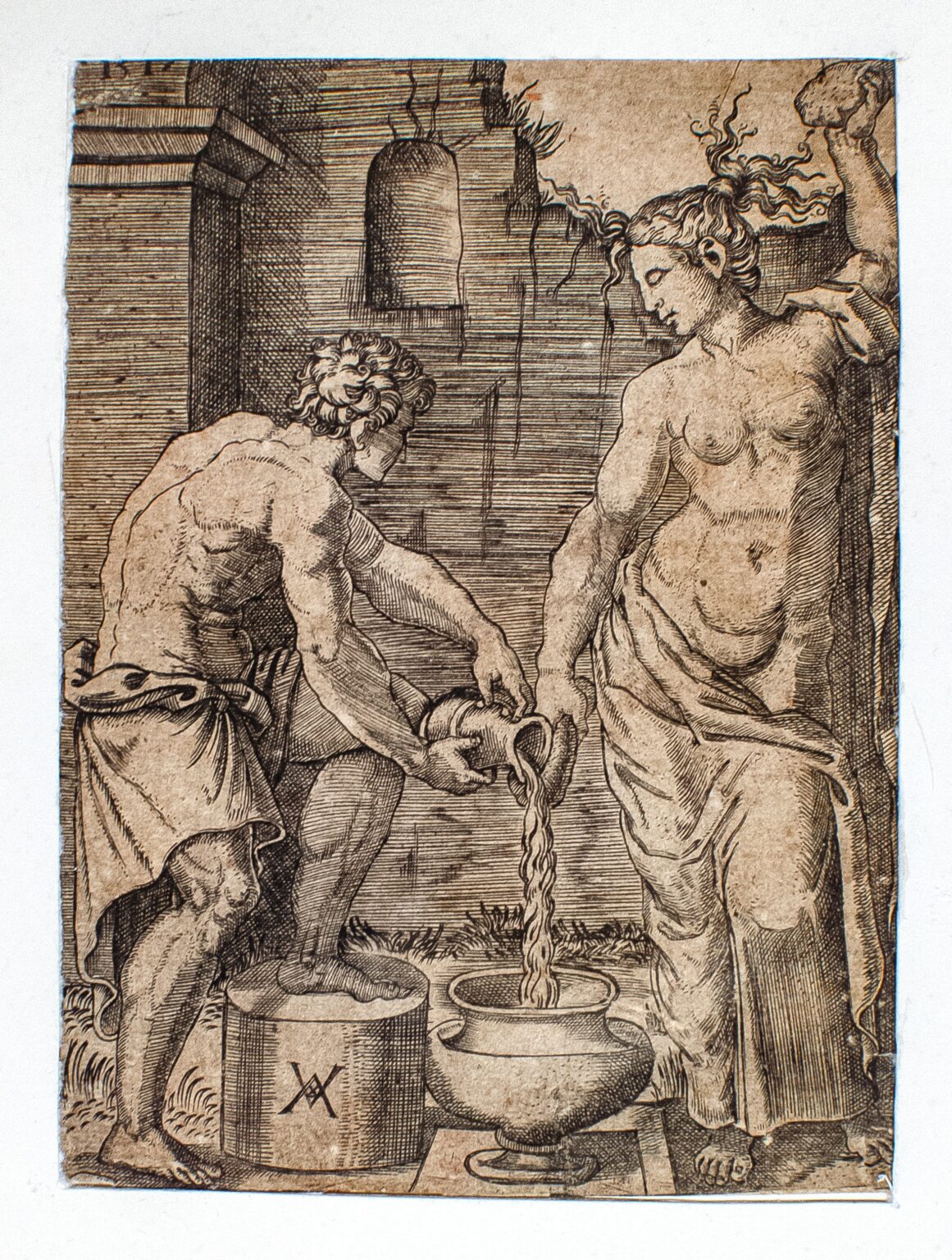
Artist: Artist Unknown, Italian School - After Marcantonio Raimondi
Artist Nationality: Italian
Artist Dates:
Title: Halfnaakte vrouw wast zich met sponzen en mannelijke bediende schenkt water in vat (Half-naked woman washes herself with sponges and male servant pours water into vessel)
Date: 1517
Condition: Slight scrape at upper left corner
Medium: Engraving
Dimensions: Sight: 4 ⅛ x 3 in.; Framed: 14 ¼ x 10 x ⅛ in.
Estimated Value: $1,000
Signature/Markings: Monogram AV lower left
This work is a copy of a similar print produced by the Italian artist Marcantonio Raimondi (Italian, 1480-1534) sometime around 1510. The image by the anonymous artist is flipped from the original Raimondi composition. The artist also added the date 1517 to the upper left corner, and included a monogram on the stool below the male figure's left foot. See the original version in the collection of the Rijksmuseum: https://www.rijksmuseum.nl/nl/collectie/object/Halfnaakte-vrouw-wast-zich-met-sponzen-en-mannelijke-bediende-schenkt-water-in-vat--ad19aabdbca1b0b049437c6efddd02cc
Another copy of Raimondi's work executed with a reversed composition is also in the Rijksmuseum collection, but it is likely it was a different artist as it is missing the 1517 dating and the added monogram: https://www.rijksmuseum.nl/nl/collectie/object/Halfnaakte-vrouw-wast-zich-met-sponzen-en-mannelijke-bediende-schenkt-water-in-vat--d02a8e2c8ab78e6dda93be48e6f8b0dd
The Rijksmuseum notes that Raimondi's composition may have been based on a drawing by the artist Francesco di Francia (1447 - 1517), a leading Bologna painter. According to the Getty: "Marcantonio Raimondi pioneered the reproduction of artwork in prints. He apparently based his over three hundred prints on other artists' designs, though he worked especially closely with Raphael. His earliest engravings date from around 1500. After studying with a Bolognese painter, Raimondi was in Venice by 1506. There he became Albrecht Dürer's most prolific copyist--though not by consent. Dürer brought successful legal proceedings against Raimondi, but Dürer's varied linework continued to inspire him for life.
In Rome by 1510, Raimondi created a financially and artistically successful business, founding a school of engravers who could accurately reproduce artworks. His style matured into a system of hatching and highlighting, concentrating on essential areas of shadow that clearly articulated forms. By 1513 Raimondi focused on engraving Raphael's works, while Raphael's assistant handled printing and marketing. After Raphael's death in 1520, Raimondi continued engraving works by his circle, notably Giulio Romano. Around 1524 Raimondi was briefly imprisoned for making erotic engravings after Giulio's designs. Following this disgrace, Raimondi was forced to ransom himself from the Spaniards during the Sack of Rome in 1527. He departed the city a beggar and left no further trace."
Provenance:
Private New York Collection, acquired from a gallery in Rome, IT
Exhibition History:
Publication History: